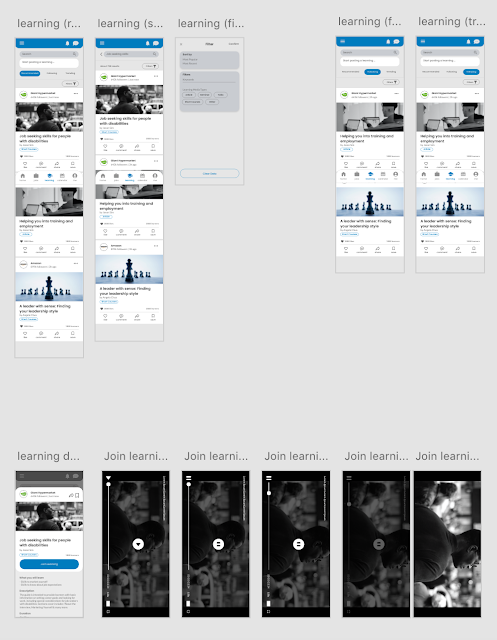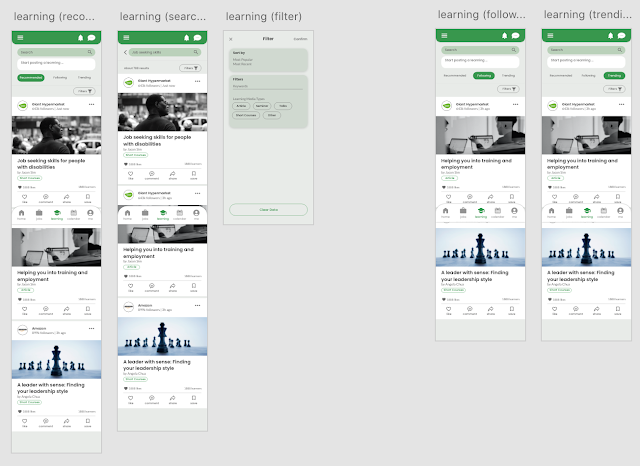CLASS EXERCISE
This week's classes focuses on our projects where the lecturer gave us some class exercise in order to let us know how to start with the project. Therefore, what we did for the class exercise was to think about the questions for the questionnaire survey of our project. It is to let us understand our project's target audience.
The document shown below is the questionnaire drafts that would be asked in the survey. It is separated into 2 categories, the disabled (primary target audience) and the employers (secondary target audience). Both categories will be asking basic information first, then following by the answers I would like to search for. After some discussion of my questionnaire drafts with the lecturer, I was being suggested to look into a few points for further improvement:
- what company that provides these job opportunities for the disables
- are these companies have friendly facilities for these disabled if they are to hire them
- what are the local disabled / NGO organisation
- research more on primary target audience & secondary target audience
[R&D] W2 - Questionaire... by CHAO CI XIN
After having suggestions from lecturer, I decided to have more research done to come up with the final questionnaire and send it out for the survey as well as data collection.
________________________________________________________________________________________________________________
Before I get into questionnaire survey and after last weeks of research on both ideas, I decide to choose "A ticket to be seen" as my project, an app aims to help the disabled person find jobs easier and more conveniently. Meanwhile, helping them to improve their life quality as well as gain awareness of these group of people.
Before I've chosen "A ticket to be seen" as my final decision, I've made some notes and finalize the idea and identify which is the better idea to work on. Below is the decision notes on both idea and why I will choose that particular idea :
As the project goes on, I did more research on this issue and understand the disabled as well as their living quality. Below are the research conducted for more understanding.
[R&D] w2 - Fyp Research... by CHAO CI XIN
From the research, I realized it will be a big project to work on for developing the ideas and more. However, how am I going to help the people in needs always one of my goals in life. The more I research, the more I felt they really deserve to be treated or to live like a normal person. They actually not really like the sympathy we've always express through our expression. What they really wanted is to just live or treated like a normal person, that's what they have been voicing out every time. Besides, most of them actually can work or do things just like everyone. It's just that the perception of the people in Malaysia that thinks disabled people equals "unavailable to do anything". As Tan Tong Hai, Chief Executive Officer of StarHub Ltd once said, "Each person is talented in his or her own way, and we should look at what they have and not what they don't have.
After conducting the researches and confirmed the questions that I would like to find out. There 2 target audience that I need to do questionnaire survey, which is the primary target audience "the disabled people" and the secondary target audience "the employers". I used GOOGLE FORM to create my questionnaire form and send it out via social media apps such as Whatapps, Instagram and Facebook. The reason that I'm using this research method (quantitative research) is to find out the answers from the audience directly as well as gather a larger amount of samples to understand my target audience for this project.
Final questionnaire in Google Form (link) :
(disabled people questionnaire) https://forms.gle/15kNH8fB9DfSAxW98
(employers questionnaire) https://forms.gle/FcRKJMK8bkedn4779
________________________________________________________________________________________________________________
References
1. Robichaud, T., 2011. 6 General Types of Disabilities | Changing Paces. [online] Changing Paces. Available at: <https://changingpaces.com/6-general-types-of-disabilities/> [Accessed 20 January 2021].2. CDC, 2020. Types of Hearing Loss | CDC. [online] Centers for Disease Control and Prevention. Available at: <https://www.cdc.gov/ncbddd/hearingloss/types.html> [Accessed 20 January 2021].
3. Rupert R A Bourne, 2017. Magnitude, temporal trends, and projections of the global prevalence of blindness and distance and near vision impairment: a systematic review and meta-analysis. [online] the lancet global health. Available at: <https://doi.org/10.1016/S2214-109X(17)30293-0> [Accessed 20 January 2021].
5. Disabled world, 2019. Disabilities: Definition, Types and Models of Disability. [online] Disabled World. Available at: <https://www.disabled-world.com/disability/types/#mobility>[Accessed 20 January 2021].
10. Ministry of Human Resources. Labour and Human Resources Statistics, 2010.
11. Yusof, A., Ali, M. and Salleh, A., 2015. Youth Workers with Disabilities: The Views of Employers in Malaysia. Procedia - Social and Behavioral Sciences, 204, pp.105-113.
12. Khoo, S., Tiun, L. and Lee, L., 2013. Workplace discrimination against Malaysians with disabilities: Living with it or fighting against it?. Disability Studies Quarterly, 33(3).
13. Omran, A., Schwarz-Herion, O. and Viehbacher, S., 2011. AWARENESS AND ATTITUDE OF UNIVERSITY STUDENTS AND STAFF ON EPILEPSY IN MALAYSIA AND ISSUES OF INTEGRATING PEOPLE WITH EPILEPSY INTO SOCIETY AND THE LABOUR MARKET IN GERMANY. [online] Semanticscholar.org. Available at: <https://www.semanticscholar.org/paper/AWARENESS-AND-ATTITUDE-OF-UNIVERSITY-STUDENTS-AND-Omran-Schwarz-Herion/19a2249399225251c69f8c37573db5546ae5d7ed> [Accessed 20 January 2021].
14. Abdullah, M.N.L.Y. & Mey, S.C.. (2011). Employment of people with disabilities in Malaysia: Drivers and inhibitors. International Journal of Special Education. 26. 112-124.
15. Baidi, Nasrudin & Ilias, Azleen & Ghazali, Ruziah. (2017). THE STUDY OF LITTLE PEOPLE IN MALAYSIA – BARRIERS AND CHALLENGES.
16. Ta, Tiun & Khoo, Suet. (2013). Challenges Faced by Malaysians with Disabilities in the World of Employment. Disability, CBR & Inclusive Development. 24. 10.5463/dcid.v24i1.142.
17. Beautiful gate foundation for the disabled, 2020. Memorandum On Employment for PWDs. [online] Beautiful gate foundation for the disabled. Available at: <https://beautifulgate.org.my/important-info/memorandum-on-employment-for-pwds/> [Accessed 20 January 2021].
19. Solovieva, T. I., D.L. Dowler, R.T. Walls. (2011). Employer benefits from making workplace accommodations. Disability and Health Journal, Vol. 4. Pp 39–45.
20. Stephen, K.H., Lita, H.J., & Erica, C.J.(2011). Why Don’t Employers Hire and Retain Workers with Disabilities? Journal of Occupational Rehabilitation. Vol. 21. No. 4. Pp 526-536.
21. C. H. Ang, M., 2017. The Challenges and Benefits of Employing Persons with Disabilities: The Japanese Multinational Corporations’ Perspective. International Journal of Innovation, Management and Technology, pp.359-366.
22. Department of Social Welfare Malaysia. (2016). Services : Disabled person's services. Retrieved from Official Portal, Department of Social Welfare: http://www.jkm.gov.my/jkm/index.php?r=portal/left&id=UnN2U3dtUHhacVN4aHNPbUlPayt2 QT09
23. Murillo, S., 2016. Top 5 Benefits of Hiring People with Disabilities - The Chicago Lighthouse. [online] The Chicago Lighthouse. Available at: <https://chicagolighthouse.org/sandys-view/top-5-benefits-hiring-people-disabilities/> [Accessed 20 January 2021].
24. Deering, S., 2020. The Importance of Offering Equal Opportunities to Disabled Employees. [online] Undercover Recruiter. Available at: <https://theundercoverrecruiter.com/benefits-disabled-employees/> [Accessed 20 January 2021].
26. Saunders SL, Nedelec B. What Work Means to People with Work Disability: A Scoping Review. J Occup Rehabil. 2014;24:100–10. [PubMed] [Google Scholar]
27. Hall JP, Kurth NK, Hunt SL. Employment as a health determinant for working-age, dually-eligible people with disabilities. Disabil Health J. 2013;6:100–6. [PubMed] [Google Scholar]
28. Disabled Person, 2021. Career Development for People with Disabilities | Disabled Person. [online] Disabledperson.com. Available at: <https://www.disabledperson.com/careeer-development-pwd> [Accessed 20 January 2021].



Comments
Post a Comment